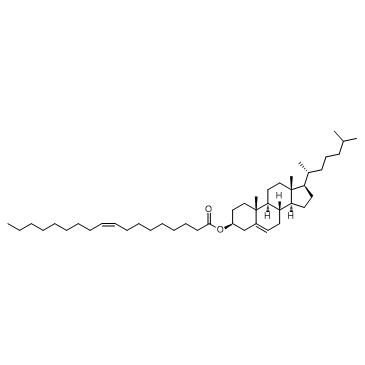Cholesteryl oleate

Cholesteryl oleate structure
|
Common Name | Cholesteryl oleate | ||
|---|---|---|---|---|
| CAS Number | 303-43-5 | Molecular Weight | 651.100 | |
| Density | 1.0±0.1 g/cm3 | Boiling Point | 675.4±44.0 °C at 760 mmHg | |
| Molecular Formula | C45H78O2 | Melting Point | 44-47 °C(lit.) | |
| MSDS | Chinese USA | Flash Point | 362.9±16.0 °C | |
|
Exploring the impact of drug properties on the extent of intestinal lymphatic transport - in vitro and in vivo studies.
Pharm. Res. 32(5) , 1817-29, (2015) Intestinal lymphatic transport of specific lipophilic drugs offers therapeutic advantages and maximises oral bioavailability. The aims of this study were; to compare intestinal lymphatic transport of a range of drugs and to investigate the influence of cyclos... |
|
|
Comparison of rheological properties, follicular penetration, drug release, and permeation behavior of a novel topical drug delivery system and a conventional cream.
Eur. J. Pharm. Biopharm. 88(3) , 614-24, (2015) A novel adapalene-loaded solid lipid microparticle (SLMA) dispersion as a topical drug delivery system (TDDS) for follicular penetration has been introduced. The objective of the present study was to investigate the rheological properties, the follicular pene... |
|
|
HMDB: a knowledgebase for the human metabolome.
Nucleic Acids Res. 37(Database issue) , D603-10, (2009) The Human Metabolome Database (HMDB, http://www.hmdb.ca) is a richly annotated resource that is designed to address the broad needs of biochemists, clinical chemists, physicians, medical geneticists, nutritionists and members of the metabolomics community. Si... |
|
|
The human serum metabolome.
PLoS ONE 6(2) , e16957, (2011) Continuing improvements in analytical technology along with an increased interest in performing comprehensive, quantitative metabolic profiling, is leading to increased interest pressures within the metabolomics community to develop centralized metabolite ref... |
|
|
Coumarins as new matrices for matrix-assisted laser-desorption/ionization Fourier transform ion cyclotron resonance mass spectrometric analysis of hydrophobic compounds.
Anal. Chim. Acta 882 , 49-57, (2015) Hydrophobic compounds with hydroxyl, aldehyde or ketone groups are generally difficult to detect using matrix-assisted laser desorption/ionization mass spectrometry (MALDI-MS), because these compounds have low proton affinity and are poorly ionized by MALDI. ... |
|
|
TORC1 inhibition induces lipid droplet replenishment in yeast.
Mol. Cell. Biol. 35(4) , 737-46, (2015) Lipid droplets (LDs) are intracellular structures that regulate neutral lipid homeostasis. In mammals, LD synthesis is inhibited by rapamycin, a known inhibitor of the mTORC1 pathway. In Saccharomyces cerevisiae, LD dynamics are modulated by the growth phase;... |
|
|
Tumor-targeted delivery of paclitaxel using low density lipoprotein-mimetic solid lipid nanoparticles.
Mol. Pharm. 12(4) , 1230-41, (2015) Water-insoluble anticancer drugs, including paclitaxel, present severe clinical side effects when administered to patients, primarily associated with the toxicity of reagents used to solubilize the drugs. In efforts to develop alternative formulations of wate... |
|
|
A rapid and precise method for quantification of fatty acids in human serum cholesteryl esters by liquid chromatography and tandem mass spectrometry.
J. Chromatogr. B. Analyt. Technol. Biomed. Life Sci. 960 , 222-9, (2014) We described a rapid and precise method for simultaneous quantification of eleven fatty acids in human serum cholesteryl esters (CEFAs) by liquid chromatography and tandem mass spectrometry (LC-MS/MS). After extraction of serum lipids with isopropanol, CEFAs ... |
|
|
Deletion of CGI-58 or adipose triglyceride lipase differently affects macrophage function and atherosclerosis.
J. Lipid Res. 55(12) , 2562-75, (2014) Cellular TG stores are efficiently hydrolyzed by adipose TG lipase (ATGL). Its coactivator comparative gene identification-58 (CGI-58) strongly increases ATGL-mediated TG catabolism in cell culture experiments. To investigate the consequences of CGI-58 defici... |
|
|
Surface properties of artificial tear film lipid layers: effects of wax esters.
Invest. Ophthalmol. Vis. Sci. 55(7) , 4448-54, (2014) The tear film lipid layer is believed to stabilize the tear film and to retard evaporation. Based on previous simple in vitro studies, the evidence for the latter property is scarce. In this study, we used complex lipid mixtures including various wax esters t... |